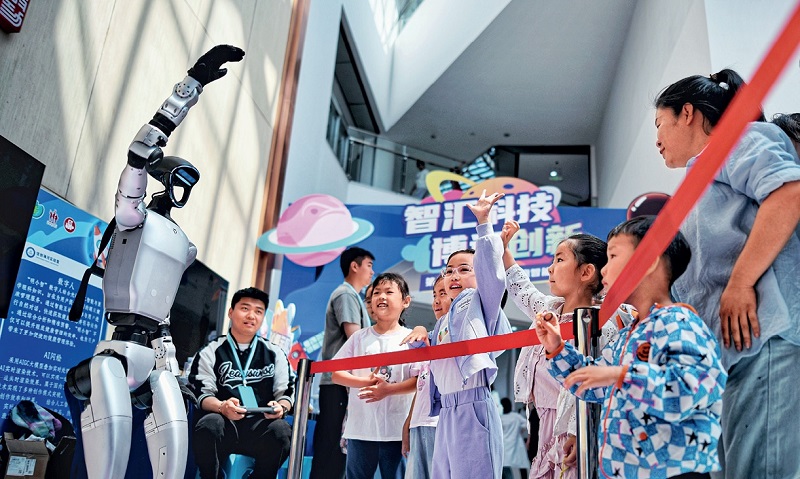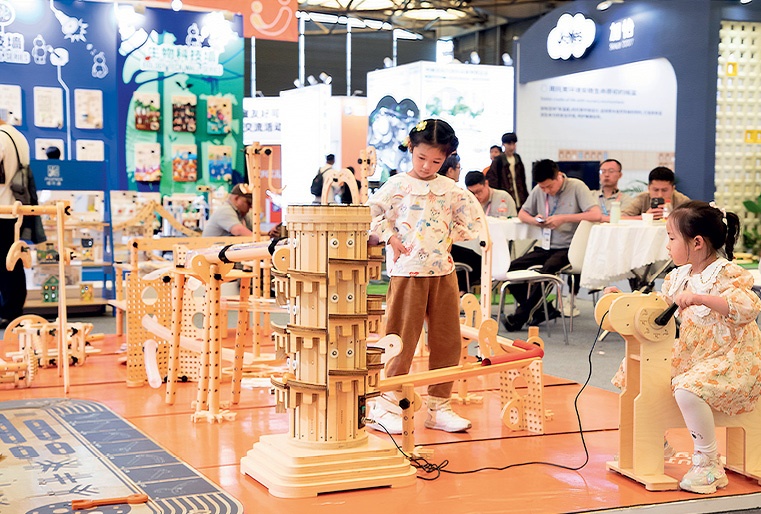In a large shopping mall in Chaoyang District, Beijing, the children’s interactive experience area was bustling with life. Many children gathered around various booths to experience firsthand the charm of smart toys, while accompanying parents listened attentively to staff members explaining product functions and safety certifications.
“Nowadays, children’s products are not only fun but also educationally and technologically smart,” said a parent who was trying out a picture book projector, “They truly allow children to learn while [they] play.”
Mall manager Liu said, “To better meet the diverse needs of kids, the mall has been optimizing product structure and service experiences. We have introduced educational interactive products, which are loved by kids and trusted by their parents.”
At the children’s toy checkout area, seven-year-old Qiqi excitedly stopped her shopping cart in front of the cashier, carefully placing each “treasure” onto the conveyor belt. The cart was filled with items she had selected by herself: an eco-friendly building block set, a small robot, and an AR (augmented reality) interactive picture book. Her mother smiled and said, “As parents, we are happy to pay for hi-tech, safe and environmentally friendly toys for our kids.”

Children immerse themselves in the world of intelligent technology at the second Beijing-Tianjin-Hebei Children’s Intelligence Expo held in Tianjin on May 17, 2025.
Intelligent and Personalized
As millennials and Gen-Z become the main demographic in parenting, consumption of children’s products is no longer confined to clothing and toys but has extended further into fields such as educational, cultural, traveling, and parent-child experiences. The 2024 China Consumer Outlook reveals that children’s education has become one of the areas Chinese consumers are most willing to invest in. Among these, emerging consumption formats like parent-child study tours and children’s education camps have gained greater favor among young parents.
“Children’s product market is becoming more diversified and intelligent,” said Dong Chao, director of the Circulation and Consumption Research Institute at the Chinese Academy of International Trade and Economic Cooperation (CAITEC) under the Ministry of Commerce, “With rising household incomes, the focus of parental spending has gradually shifted from basic necessities to service-oriented domains like education, entertainment, and health. For the Children’s Day (June 1), they not only purchase toys and apparel but also take their children on parent-child tours and to see performances.”
From toy robots to AR interactive picture books, behind these items lies the digital transformation of the children’s product market in China. Dong said, “Digitalization has become a pivotal force. The application of digital technologies has made children’s product consumption more convenient and diversified. Parents flock to e-commerce platforms and access parenting information through social media. This online-offline integrated consumption model enhances user experience and propels market growth.”
Beyond this, spending on digital content is also on the rise. The emergence of educational apps, online learning platforms, and multilingual picture book subscription services meets the developmental needs of children across age groups. Taking the United States as an example, platform-based content providers like ABCmouse and Khan Academy Kids have attracted tens of millions of family subscriptions through gamified learning and age-tiered curricula. In Europe, digital libraries specializing in interactive reading and language learning are rapidly expanding, supporting language options to help children engage with diverse cultures from an early age. At the same time, an increasing number of content-providing platforms are working with educational institutions and publishers to build richer, safer, and more culturally inclusive content ecosystems.
Going Green
Green consumption and sustainable concepts are another rapid shift in household purchasing decisions. When you step into shopping malls or log onto e-commerce platforms, labels such as “eco-friendly,” “non-toxic,” or “biodegradable” catch your attention.
Items ranging from clothing made of natural cotton and bamboo fiber and picture books using renewable materials and eco-friendly printing techniques, to reusable BPA-free cups and tableware, have gained widespread popularity among parents. As Ms. Li, a working mother from Beijing, explained, “Our kids are exposed to so many products every day, which we hope are healthier, and more sustainable – [so that] they benefit both our kids and the environment.”
Dong noted that this is not only an evolution in consumption concepts but also an extension of education. By making green choices through household purchases, children’s environmental awareness is cultivated, laying the groundwork for a sustainable society. In his eyes, as policy guidance, corporate transformation, and family values continue evolving, this green consumption trend on the children’s market will become more prominent. “Environmental responsibility is no longer confined to adults but has become an intrinsic part of childhood development,” Dong stressed.
Globally, as environmental protection and sustainable development gain widespread recognition, children’s product manufacturers are adopting eco-friendly materials and green production methods to meet consumer demands. Many domestic children’s brands have also responded to this green shift in their production processes.
The renowned Chinese children’s brand Goodbaby has significantly advanced its use of eco-materials in recent years, incorporating renewable and biodegradable materials into strollers and apparel, while adopting energy-saving and emission-reduction technologies to lower its carbon footprint. Balabala has launched its “Eco-Childrenswear” line featuring organic cotton and eco-friendly dyes to minimize the negative impact on children’s skin and the environment, while reducing plastic usage in packaging to promote recyclability. Meanwhile, YeeHoO uses GOTS (Global Organic Textile Standard) fabrics for infant clothing and enhanced wastewater and waste management protocols in manufacturing.
Driven by both policy incentives and market forces, the green transformation has emerged as a critical pathway for high-quality development in the industry. Moving forward, the establishment of green supply chains, implementation of full product lifecycle design, and enhanced carbon footprint transparency will serve as key metrics for evaluating corporate sustainability performance. “For Chinese children’s brands,” Dong emphasized, “embracing the dual-drive strategy of ‘environmental protection + good quality’ presents significant potential to cultivate a more proactive and responsible brand image in global markets.”

Little girls try out new children’s products at the China Kids Fair in Shanghai on October 18, 2024.
Going Global
On the global scale, the flourishing children’s product market is undergoing another quiet transformation. China has evolved from serving solely as the “world’s factory” for contract manufacturing exports to increase the presence of domestic brands globally.
As Dong observed, children’s products industry in China long operated primarily through original equipment manufacturing (OEM), providing cost-efficient production for major Western and Japanese brands. However, this OEM-centric development model relegated Chinese companies to a subordinate position in the value chain, limiting their core competitiveness and pricing power.
Stimulated by maturing domestic markets with upgraded consumption demands, alongside rising international standards for product design and quality, forward-looking enterprises have pivoted toward proprietary brand operations. This strategic move propels product innovation and brand building while expanding their footprint into diverse markets.
According to data from the China Toy & Juvenile Products Association (CTJPA), by the end of 2024, over 300 of China’s children’s products enterprises had initiated overseas brand expansion, with many achieving notable breakthroughs across Southeast Asian, Middle Eastern, and European markets.
During this process, innovation has become the crucial driving force. Diverging from the historical pattern that prioritized manufacturing over design, an increasing number of enterprises now focus on product originality and cultural resonance, conducting personalized research and development tailored to regional user habits.
Certain companies integrate traditional Chinese cultural elements into the design of toys, picture books, and smart early-age education products, endowing their offerings with distinct cultural identities in overseas markets. Concurrently, to comply with international safety regulations, manufacturers align their materials, craftsmanship, and testing protocols with global standards such as the EU’s CE (Conformité Européenne) Certification and U.S. ASTM (American Society for Testing and Materials) standards, substantially enhancing product competitiveness. .
Furthermore, widespread adoption of digital tools accelerates product iteration. Through data-driven analysis of consumer needs, enterprises rapidly optimize product features while compressing R&D-to-market cycles, establishing competitive advantages for brand building abroad.
According to an official from the CTJPA, children’s product enterprises in China are now evolving from a singular export-oriented approach toward a new phase of omni-channel global expansion that integrates online and offline strategies. Beyond leveraging established cross-border e-commerce platforms like Amazon, Lazada, and Shopee, many brands are establishing localized sales networks, participating in international trade fairs, and partnering with local educational institutions.
While children’s products in China have achieved initial success in international markets, the industry still faces significant challenges. Language and cultural barriers, lack of brand awareness, insufficient intellectual property protection, and global market volatility impose heightened demands on companies’ globalization strategies.
“To build enduring global advantages, the children’s product sector must prioritize sustained R&D investment, brand cultivation, and deeper alignment with international standards,” Dong emphasized. “Meanwhile, government support in policy guidance, trade facilitation, and IP protection will play a positive role.”
As Chinese companies continue enhancing their innovation capabilities and advancing brand strategies, a global shift from “Made in China” to “Created in China” is steadily reshaping the children’s product landscape. Qiqi’s mother voiced the aspirations of many when she said, “I hope someday soon, children abroad will be playing joyfully with eco-friendly toys bearing the ‘Designed and Made in China’ label.”
Each small toy cart carries not just playthings – it holds the promise of a brighter future.